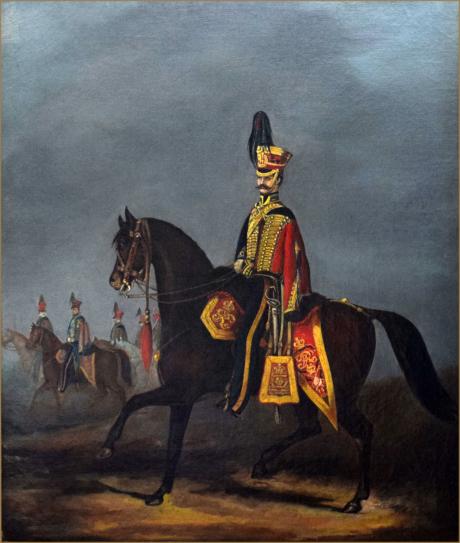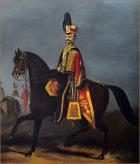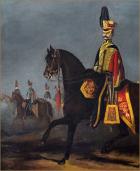The Portrait shows an Officer of the 15th (King's) . The scarlet pelisse was not introduced until 1831. and the sabretache no earlier than 1832. The cipher on the shabraque is unclear but obviously 'VR' and the painting dates to 1837 to about 1842 when the scarlet pelisse was abolished.The regiment is shown on the rear point of the shabraque where the artist has clearly shown 15 KH at the lowest point.
The 15th The King's Hussars was a cavalry regiment in the British Army. First raised in 1759, it saw service over two centuries, before being amalgamated with the 19th Royal Hussars into the 15th/19th The King's Royal Hussars in 1922. The regiment was raised as the first of the new regiments of light dragoons in 1759, and named Elliots Light Horse, after George Augustus Eliott, 1st Baron Heathfield who had raised the regiment, he was previously lieutenant colonel of the 2nd Troop of Horse, Grenadier Guards. The unit Eliott raised was immediately numbered the 15th (or Light) Regiment of Dragoons and deployed to join the Allied army in Germany in June the following year.Its first engagement was at Emsdorf in July that year, where it suffered two-thirds of the total allied casualties, including six dead by heatstroke, and won the first-ever battle-honour awarded to a British regiment.
It was then renamed the 15th Regiment of (Light) Dragoons. In 1760 the 15th was the first unit in the British Army to be awarded the battle honour "Emsdorf" for the Battle of Emsdorf in the Seven Years' War. Other more senior units then applied to be awarded battle honours for previous campaigns and battles.
In 1766 they were renamed for George III as the 1st (or The King's Royal) Regiment of Light Dragoons, the number being an attempt to create a new numbering system for the light dragoon regiments. However, the old system was quickly reestablished, with the regiment returning as the 15th (The King's) Regiment of (Light) Dragoons in 1769. They became hussars in 1807, as the 15th (The King's) Regiment of (Light) Dragoons (Hussars).They fought in the Netherlands during the early stages of the French Revolutionary Wars and were converted into a hussar regiment in 1807 before being sent to Spain a year later. There it joined up with Sir John Moore’s force before charging uphill through snow against French chasseurs and dragoons at Sahagun on 21 December 1808.
In 1819, the 15th played a pivotal role in the notorious Peterloo Massacre, where a 60,000 strong crowd calling for democratic reform were charged by the Yeomanry. Panic from the crowd was interpreted as an attack on the Yeomanry and the Hussars (led by Lieutenant Colonel Guy L'Estrange) were ordered in. The charge resulted in 15 fatalities and as many as 600 injured.
The title was simplified in 1861 to the 15th (The King's) Hussars. At the start of the First World War in August 1914, the 15th The King's Hussars was stationed at Longmoor. They moved to France on 18 August 1914, landing at Rouen. The squadrons were attached to different infantry divisions to form the divisional reconnaissance element: The regiment spent the whole of the First World War on reconnaissance and dismounted duties on the Western Front, before being merged with the 19th Royal Hussars (Queen Alexandra’s Own) in 1922 to form the 15th/19th The King’s Royal Hussars.
A Squadron was attached to 3rd Division
B Squadron was attached to 2nd Division
C Squadron was attached to 1st Division
On 14 April 1915, the squadrons returned to regimental control and the regiment was placed under the command of the 9th Cavalry Brigade in the 1st Cavalry Division.
The regiment remained on the Western Front throughout the war. It participated in most of the major actions where cavalry were used as a mounted mobile force. They were also used as dismounted troops and served effectively as infantry. On 11 November 1918, orders were received that the 1st Cavalry Division would lead the advance of the Second Army into Germany, by 6 December, having passed through Namur, the division secured the Rhine bridgehead at Cologne.
After service in the First World War, the regiment, retitled as the 15th The King's Hussars in 1921, was amalgamated with the 19th Royal Hussars (Queen Alexandra's Own) to form the 15th/19th Hussars the following year.
The Regiment was awarded the following battle honours:
Emsdorf, Villers-en-Cauchies, Willems, Egmont-op-Zee, Sahagun, Vittoria, Peninsula, Waterloo, Afghanistan 1878-80
The Great War: Mons, Retreat from Mons, Marne 1914, Aisne 1914, Ypres 1914 '15, Langemarck 1914, Gheluvelt, Nonne Bosschen, Frezenberg, Bellewaarde, Somme 1916 '18, Flers-Courcelette, Cambrai 1917 '18, St. Quentin, Rosières, Amiens, Albert 1918, Bapaume 1918, Hindenburg Line, St. Quentin Canal, Beaurevoir, Pursuit to Mons, France and Flanders 1914-18



